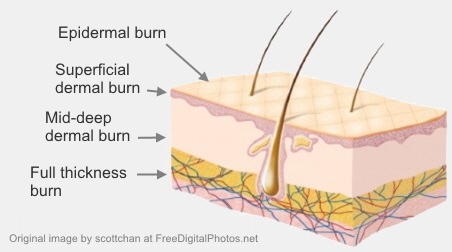Burns
Burns can range from minor burns you can treat at home to major burns that need to be treated in hospital. All burns need immediate first aid.
Types of burns
There are different types of burns according to how deeply they have burned your skin and how much of your skin they cover.
Burns first aid
Minor burns
There are 2 types of minor burns.
Epidermal burn or erythema (redness)
- The skin is dry and red, but without blisters.
- Skin will hurt when touched.
- Healing takes around 7 days.
- The burn usually heals without scarring.
Superficial dermal burn (first degree burn)
- The skin often has blisters.
- Skin will look pink and moist and be painful.
- Healing may take 10 days
- Burns that take longer to heal may leave scars.
Major burns
When burns are deep or cover a large area, they are considered major burns. There are 2 types of major burn.
Mid-deep dermal burn (second degree burn)
- The skin will usually have large blisters and be dark pink, blotchy red or white
- The burn may not be very painful
- Healing is very slow.
Full thickness burn (third degree burn)
- The burn wound will be white, yellow, brown or black
- There is usually little or no pain (but surrounding dermal burns will be very painful)
- This type of burn generally needs a skin graft
- There will be scarring.
A burn might also be considered major if it:
- is to your face, hands, feet, genitals, joints or eyes
- is electrical (you might not realise how serious it is as the damage can be internal or under the skin)
- is chemical
- goes the whole way around part of your body such as an arm, leg or neck.
When to get help for a burn
Take the burned person to a healthcare provider if:
- they are a tamaiti or older person
- the burn is large (bigger than the palm of their hand)
- blisters form on the burn
- their face, hands, feet, genitals, joints or eyes are burned
- the burn is electrical (you might not realise how serious it is as the damage can be internal or under the skin)
- the burn is chemical
- they might have breathed in smoke or toxic gas
- the burn goes the whole way around part of their body such as an arm, leg or neck
- they are not up to date with their tetanus immunisation
- there are signs of an infection (a bad smell, weeping, increased pain, increased redness, feeling generally unwell)
- you have any concerns.
Treating minor burns
You can manage most minor burns at home.
Use non-stick dressings against the burn to keep it moist and clean. If a burn dries out and forms a scab, it takes longer to heal.
Burns can weep. This is normal, but you may need a second padded dressing that you change regularly to keep the outside of the dressings next to the burn dry. This helps to stop the wound from becoming infected.
Do not burst your blisters. This can increase the risk of an infection.
Keep the burned area raised. This can reduce swelling and help with pain and healing.
Treating major burns
Major burns need treatment from a healthcare provider. For the most severe burns, you will need specialist care at hospital.
Your treatment may include special dressings. You may also need one or more operations. These are usually done by a plastic surgeon or at a specialist burns unit.
There are 2 main types of procedures — debridement and skin grafting.
Debridement is when dead or damaged tissue is removed.
Skin grafts are used for most full thickness (third degree) and some mid-deep (second degree) burns to improve and speed up healing. They can also be used when skin around a scar is too tight (contracture) or to make the wound look better.
Your healthcare provider can refer you to a specialist who can help you minimise the effects of scarring.
Complications of major burns
Scarring is the most common complication of a burn. Sometimes a burn scar can pull the skin together too tightly, restricting movement. This is known as contracture and may need surgery.
Burns can also cause other serious problems, such as fluid and heat loss. This is because when the skin is damaged, it leaks fluid and lets out heat. With very severe burns this can be life-threatening.
Burn wounds can also get infected. This can cause significant illness, delay their healing and make it more likely they will scar.
Caring for healed skin
Your scar will be very sensitive to the sun for at least a year. You should cover it with a sunscreen of at least SPF 30 or with UV protective clothing at all times.
You will need to moisturise the skin at least twice a day to stop it from becoming dry and itchy. If the scar feels like it is becoming dry, tight or itchy, moisturise it again. Use any non-perfumed moisturiser that you know you are not sensitive to. It does not need to be an expensive product. If your scar continues itching, tell your healthcare provider.
You can swim once your wounds have completely healed. Protect your wound from the sun if you are swimming outside. Once you have finished swimming, rinse off any chlorinated or salty water and thoroughly moisturise your skin again.
Coping and emotional recovery
If you have had a major burn, this can have a significant emotional impact on you and your whānau. Talk to any of the team caring for you if you need extra support. There are some specialist services you can be referred to. Support groups can help as well.
